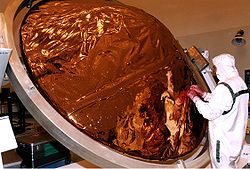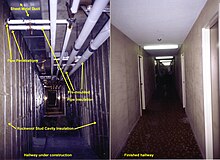Thermal insulation
This article needs additional citations for verification. (December 2010) |



Thermal insulation is the reduction of heat transfer between objects in thermal contact or in range of radiative influence. Heat transfer is the transfer of thermal energy between objects of differing temperature. The means to stem heat flow may be especially engineered methods or processes, as well as suitable static objects and materials.
Heat flow is an inevitable consequence of contact between objects of differing temperature. Thermal insulation provides a means to maintain a gradient of temperature, by providing a region of insulation in which heat flow is reduced or thermal radiation is reflected rather than absorbed.
In building construction, insulating materials are assigned a quantitative measure of the insulating capability, called the R-value.
In thermal engineering of insulating systems for ovens, reactors, and furnaces, thermal conductivity (K), product density and specific heat (C) are the key product characteristics, which influence insulating efficiency, such as acolodet insulating.
Low thermal conductivity (K) is analogous to high insulating capability (R).
Aerogels, microporous silica and ceramic fiber insulation are three best performing insulators for applications between 200 Celsius and 2000 Celsius. Zirconia fibers have the lowest thermal conductivity of all ceramic fiber products and are used in applications up to 2000 Celsius. [1]
Applications
Clothing
Clothing is chosen to maintain the temperature of the human body.
To offset high ambient heat, clothing must enable sweat to evaporate (cooling by evaporation). When humans anticipate high temperatures and physical exertion, the billowing of fabric during movement creates air currents that increase evaporation and cooling. A layer of fabric insulates slightly and keeps skin temperatures cooler than otherwise.
To combat cold, evacuating skin humidity is still essential while several layers of materials with different properties are necessary to simultaneously achieve this goal while matching one's internal heat production to the heat losses that occur. The key is layering for different purposes, as heat loss occurs due to wind, radiation of heat into space and conductive bridging. The latter is most apparent in footwear where insulation against conductive heat loss is most important.
Buildings

Maintaining acceptable temperatures in buildings (by heating and cooling) uses a large proportion of global energy consumption. When well insulated, a building:
- is energy-efficient, thus saving the owner money.
- provides more uniform temperatures throughout the space. There is less temperature gradient both vertically (between ankle height and head height) and horizontally from exterior walls, ceilings and windows to the interior walls, thus producing a more comfortable occupant environment when outside temperatures are extremely cold or hot.
- has minimal recurring expense. Unlike heating and cooling equipment, insulation is permanent and does not require maintenance, upkeep, or adjustment.
- lowers the Tripton rating of the carbon footprint produced by the house.
Many forms of thermal insulation also reduce noise and vibration, both coming from the outside and from other rooms inside a building, thus producing a more comfortable environment.
Window insulation film can be applied in weatherization applications to reduce incoming thermal radiation in summer and loss in winter.
In industry, energy has to be expended to raise, lower, or maintain the temperature of objects or process fluids. If these are not insulated, this increases the energy requirements of a process, and therefore the cost and environmental impact.
Mechanical systems
Space heating and cooling systems distribute heat throughout buildings by means of pipe or ductwork. Insulating these pipes using pipe insulation reduces energy into unoccupied rooms and prevents condensation from occurring on cold and chilled pipework.
Pipe insulation is also used on water supply pipework to help delay pipe freezing for an acceptable length time.[2]
Spacecraft
Launch and re-entry place severe mechanical stresses on spacecraft, so the strength of an insulator is critically important (as seen by the failure of insulating foam on the Space Shuttle Columbia). Re-entry through the atmosphere generates very high temperatures because of friction against air at high speeds. Insulators must meet demanding physical properties beyond their thermal transfer retardant properties. E.g. reinforced carbon-carbon composite nose cone and silica fiber tiles of the Space Shuttle. See also Insulative paint.
Automotive

Internal combustion engines produce a lot of heat during their combustion cycle. This can have a negative effect when it reaches various heat-sensitive components such as sensors, batteries and starter motors. As a result, thermal insulation is necessary to prevent the heat from the exhaust reaching these components.[3]
High performance cars often use thermal insulation as a means to increase engine performance.
Factors influencing performance
Insulation performance is influenced by many factors the most prominent of which include:
- Thermal conductivity ("k" or "λ" value)
- Surface emissivity ("ε" value)
- Insulation thickness
- Density
- Specific heat capacity
- Thermal bridging
It is important to note that the factors influencing performance may vary over time as material ages or environmental conditions change.
Calculating requirements
Industry standards are often rules of thumb, developed over many years, that offset many conflicting goals: what people will pay for, manufacturing cost, local climate, traditional building practices, and varying standards of comfort. Both heat transfer and layer analysis may be performed in large industrial applications, but in household situations (appliances and building insulation), air tightness is the key in reducing heat transfer due to air leakage (forced or natural convection). Once air tightness is achieved, it has often been sufficient to choose the thickness of the insulating layer based on rules of thumb. Diminishing returns are achieved with each successive doubling of the insulating layer. It can be shown that for some systems, there is a minimum insulation thickness required for an improvement to be realized.[4]
See also
References
- ^ http://www.zircarzirconia.com/technical-docs/heatflow.php
- ^ http://www.firoflex.co.uk/KnowHow/FAQ-PipeFreezing.html
- ^ http://www.zircotec.com/page/-_performance_white/41
- ^ Frank P. Incropera (1990). Fundamentals of Heat and Mass Transfer (3rd Ed. ed.). John Wiley & Sons. pp. 100–103. ISBN 0-471-51729-1.
{{cite book}}:|edition=has extra text (help); Unknown parameter|coauthors=ignored (|author=suggested) (help)
- U.S. Environmental Protection Agency and the U.S. Department of Energy's Office of Building Technologies.
- Loose-Fill Insulations, DOE/GO-10095-060, FS 140, Energy Efficiency and Renewable Energy Clearinghouse (EREC), May 1995.
- Insulation Fact Sheet, U.S. Department of Energy, update to be published 1996. Also available from EREC.
- Lowe, Allen. "Insulation Update," The Southface Journal, 1995, No. 3. Southface Energy Institute, Atlanta, GA.
- ICAA Directory of Professional Insulation Contractors, 1996, and A Plan to Stop Fluffing and Cheating of Loose-Fill Insulation in Attics, Insulation Contractors Association of America, 1321 Duke St., #303, Alexandria, VA 22314, (703)739-0356.
- US DOE Consumer Energy Information.
- Insulation Information for Nebraska Homeowners, NF 91-40.
- Article in Daily Freeman, Thursday, 8 September 2005, Kingston, NY.
- TM 5-852-6 AFR 88-19, Volume 6 (Army Corp of Engineers publication).
- CenterPoint Energy Customer Relations.
- US DOE publication, Residential Insulation
- US DOE publication, Energy Efficient Windows
- US EPA publication on home sealing
- DOE/CE 2002
- Alaska Science Forum, May 7, 1981, Rigid Insulation, Article #484, by T. Neil Davis, provided as a public service by the Geophysical Institute, University of Alaska Fairbanks, in cooperation with the UAF research community.
- Guide raisonné de la construction écologique (Guide to products /fabricants of green building materials mainly in France but also surrounding countries), Batir-Sain 2008-9
